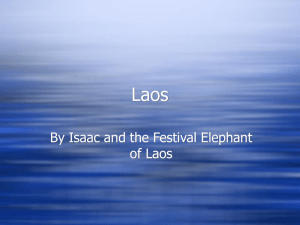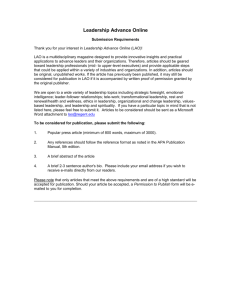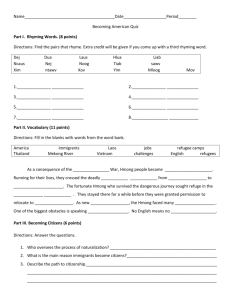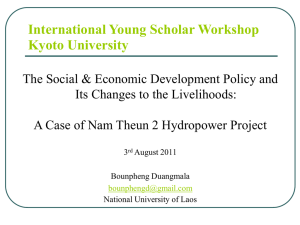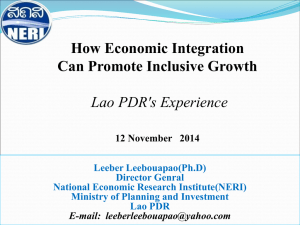Culture - Aida's ePortfolio
advertisement
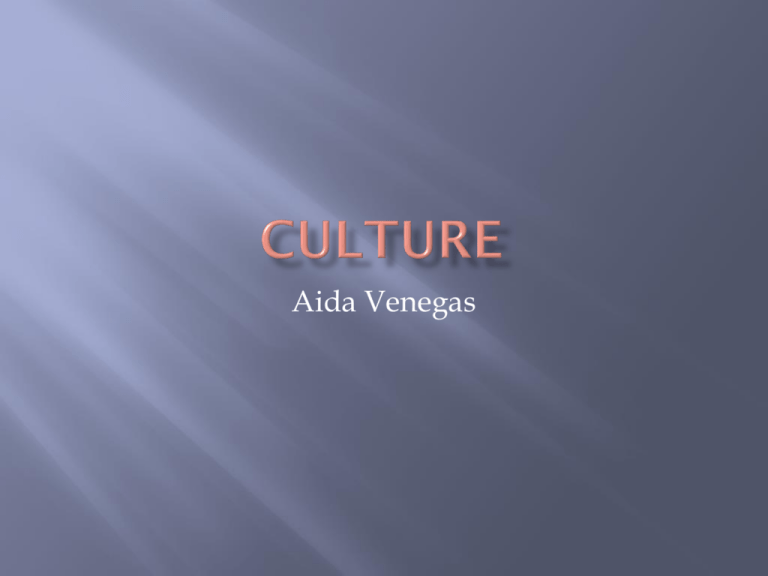
Aida Venegas Slide 5 – Definition of Culture Slide 6 – Mexican Lanugage Slide 7 – Mexican Values Slide 8 – Mexican Customs Slide 9 – Graph: Mexican Population Slide 10 – Europe Values Slide 11 – Europe Language Slide 12 – Europe Food Slide 13 - Graph: Europe Population Slide 14 - China’s History Slide 16 – China’s Food Slide 17 – Graph: China’s Population Slide 18 - Laos Language Slide 19 - Laos Food Slide 20 – Laos History Slide 21 – Graph: Laos Population Slide 22 - Thailand Language Slide 23 – Graph: Thailand Population Slide 24 – Reflection Paper In the twentieth century, "culture" emerged as a concept central to anthropology, encompassing all human phenomena that are not purely results of human genetics. Specifically, the term "culture" in American anthropology had two meanings: (1) the evolved human capacity to classify and represent experiences with symbols, and to act imaginatively and creatively; and (2) the distinct ways that people living in different parts of the world classified and represented their experiences, and acted creatively. A distinction is current between the physical artifacts created by a society, its so-called material culture and everything else, the intangibles such as language, customs, etc. that are the main referent of the term "culture". Language in Mexico Spanish control of Mexico led to the dominance of Spanish, the official language. As many as 100 Native American languages are still spoken in Mexico, but no single alternative language prevails. Eighty percent of those Mexicans who speak an indigenous language also speak Spanish. The most important of the Native American languages is Nahuatl. It is the primary language of more than a million Mexicans and is spoken by nearly one-fourth of all Native Americans in the country. This is followed by Maya, used by 14 percent of Native Americans, and Mixteco and Zapoteco, each spoken by about seven percent of Native Americans. No other indigenous language is spoken by more than five percent of Mexico's Native Americans. . The family is at the centre of the social structure. . Outside of the major cosmopolitan cities, families are still generally large. . The extended family is as important as the nuclear family since it provides a sense of stability. . Mexicans consider it their duty and responsibility to help family members. For example, the will help find employment or finance a house or other large purchase. . Most Mexican families are extremely traditional, with the father as the head, the authority figure and the decision-maker. . Mothers are greatly revered, but their role may be seen as secondary to that of their husband. Mexican society and business are highly stratified and vertically structured. . Mexicans emphasize hierarchical relationships. . People respect authority and look to those above them for guidance and decision-making. . Rank is important, and those above you in rank must always be treated with respect. . This makes it important to know which person is in charge, and leads to an authoritarian approach to decision-making and problem- solving. . Mexicans are very aware of how each individual fits into each hierarchy--be it family, friends or business. . It would be disrespectful to break the chain of hierarchy. Machismo . Machismo literally means 'masculinity'. . There are different outward behaviours to display machismo. . For example, making remarks to women is a stereotypical sign of machismo and should not be seen as harassment. . Mexican males generally believe that nothing must be allowed to tarnish their image as a man. Mexican society and business are highly stratified and vertically structured. . Mexicans emphasize hierarchical relationships. . People respect authority and look to those above them for guidance and decisionmaking. . Rank is important, and those above you in rank must always be treated with respect. . This makes it important to know which person is in charge, and leads to an authoritarian approach to decision-making and problem- solving. . Mexicans are very aware of how each individual fits into each hierarchy--be it family, friends or business. . It would be disrespectful to break the chain of hierarchy. 'Machismo' . Machismo literally means 'masculinity'. . There are different outward behaviours to display machismo. . For example, making remarks to women is a stereotypical sign of machismo and should not be seen as harassment. . Mexican males generally believe that nothing must be allowed to tarnish their image as a man. . When greeting in social situations, women pat each other on the right forearm or shoulder, rather than shake hands . Men shake hands until they know someone well, at which time they progress to the more traditional hug and back slapping. . Wait until invited before using a Mexican's first name Gift Giving Etiquette . If invited to a Mexican's house, bring a gift such as flowers or sweets. . Gift wrapping does not follow any particular protocol. . Do not give marigolds as they symbolize death. . Do not give red flowers as they have a negative connotation. . White flowers are a good gift as they are considered uplifting. . Gifts are opened immediately. . If you receive a gift, open it and react enthusiastically. Dining Etiquette If you are invited to a Mexican's home: . Arrive 30 minutes late in most places (check with colleagues to see if you should arrive later than that). . Arriving on time or early is considered inappropriate. . At a large party you may introduce yourself. . At a smaller gathering the host usually handles the introductions. Watch your table manners! . Always keep your hands visible when eating. Keep your wrists resting on the edge of the table. . When you have finished eating, place your knife and fork across your plate with the prongs facing down and the handles facing to the right. . Do not sit down until you are invited to and told where to sit. . Do not begin eating until the hostess starts. . Only men give toasts. . It is polite to leave some food on your plate after a meal. 5 4.5 4 3.5 3 2002 2.5 2001 2 2000 1.5 1 0.5 0 Mexico In recent decades the European Union has been seeking to identify and support common European values, however this has turned out to be a highly controversial issue. Some commentators wish to classify social cohesion and solidarity as European values and contrast them with more individualist values in the United States. The distinction is not a simple one, but is perhaps most fundamentally reflected in differing attitudes to government, notably in terms of trust in the government. Language is a very important part of culture, and Europe has a widespread variety of languages, with most countries having at least one official language. Russian is the largest language in Europe, followed by German. Many regional languages are also spoken, some enjoying a level of official status or recognition. Other minority languages are also spoken. The diversity on such a small territory is proverbial. The European Union alone uses 20 official languages, which all have the same status. The cost of translation is so high that the official language of the Union is an ongoing debate, since many MEPs are bilingual and most languages have a great level of prestige. European cuisine, or alternatively Western cuisine,is a generalised term collectively referring to the cuisines of Europe and other Western countries. European cuisine or Western cuisine includes that of Europe including (depending on the definition) that of Russia, as well as non-indigenous cuisines of North America, Australasia, Philippines, Oceania, and Latin America, which derive substantial influence from European settlers in those regions. The term is used by East Asians to contrast with Asian styles of cooking. (This is analogous to Westerners referring collectively to the cuisines of East Asian countries as Asian cuisine.) When used by Westerners, the term may sometimes refer more specifically to cuisine in Europe or continental; in this context, a synonym is Continental cuisine, especially in British English. Grilled steak Frites (french fries) The cuisines of Western countries are diverse by themselves, although there are common characteristics that distinguishes Western cooking from cuisines of Asian countriesnd others. Compared with traditional cooking of Asian countries, for example, meat is more prominent and substantial in serving-size. Steak in particular is a common dish across the West. Similarly to some Asian cuisines, Western cuisines also put substantial emphasis on sauces as condiments, seasonings, or accompaniments (in part due to the difficulty of seasonings penetrating the often larger pieces of meat used in Western cooking). Many dairy products are utilised in the cooking process, except in nouvelle cuisine. Wheat-flour bread has long been the most common sources of starch in this cuisine, along with pasta,dumplings and pastries, although the potato has become a major starch plant in the diet of Europeans and their diaspora since the European colonisation of the Americas. Maize is much less common in most European diets than it is in the Americas; however corn meal, or polenta, is a major part of the cuisine of Italy and the Balkans. Population 2004 2005 2006 2007 China, one of the countries that can boast of an ancient civilization, has a long and mysterious history - almost 5,000 years of it! Like most other great civilizations of the world, China can trace her culture back to a blend of small original tribes which have expanded till they became the great country we have today. It is recorded that Yuanmou man is the oldest hominoid in China and the oldest dynasty is Xia Dynasty. From the long history of China, there emerge many eminent people that have contributed a lot to the development of the whole country and to the enrichment of her history. Among them, there are emperors like Li Shimin (emperor Taizong of the Tang), philosophers like Confucius, great patriotic poets like Qu Yuan and so on. Chinese society has progressed through five major stages - Primitive Society, Slave Society, Feudal Society, Semi-feudal and Semi-colonial Society, and Socialist Society. The rise and fall of the great dynasties forms a thread that runs through Chinese history, almost from the beginning. Since the founding of the People's Republic of China on October 1st, 1949, China has become a socialist society and become stronger and stronger. With a profound history of over 4,000 years, Chinese tea is regarded as an exquisite art form that requires sampling. Now it has become the national drink and one of the three soft drinks in the world (the other two are coffee and cocoa). It is from China that the tea planting techniques, processing, drinking methods and tea ceremony were directly or indirectly introduced to the world. So China is regarded proudly as the hometown of tea. The land can be divided into four tea growing regions: South China, Southwestern China, and Yangtze River's north and south banks. These vast tea planting areas widely grow various kinds of tea trees. Different teas require different tea sets to infuse the best flavor. Chinese tea sets mainly include teacup, teapot and tea saucer. Their materials differ in porcelain, pottery, lacquer ware, glass, bamboo and wooden fish stone. What's more, tea ceremony, the soul of tea culture, is considered to be a good way to cultivate the minds. Through infusing, appreciating and tasting tea, people can nourish their inborn nature and promote friendship among each other. Generally speaking, Chinese people do not have a strong religious inclination but despite this the three main faiths have had a considerable following. The fact that Confucianism is a philosophy rather than religion meant that it became the orthodox doctrine for Chinese intellectuals in the days of the feudalist society. However, these intellectuals did not stick to their doctrine as a believer clings to his belief. Someone summarized the true attitude of Chinese intellectuals as - they followed the teachings of Confucius and Mencius when they were successful but would turn to Taoism when they were frustrated. Many people say they are Buddhists yet have never read the sutras. Most people will say they believe in gods, destiny, fate, luck and an afterlife. Even so, on most occasions, rather than rely on prayer, people will make decisions all by themselves or resort to either family or friends for help. A visible human being is considered far more reliable than invisible gods or spirits. Column1 1.29E+09 1.285E+09 1.28E+09 1.275E+09 1.27E+09 Column1 1.265E+09 1.26E+09 1.255E+09 1.25E+09 1.245E+09 2000 2001 2002 2003 Lao or Laotian is the official language of Laos. It is the primary language of the Lao people, and is also spoken in the northeast of Thailand, where it is referred to as Isan language. As most ethnic groups in Laos have their own dialects, Lao is an important second language for them as a central language to communicate with outsiders. There are variations in vocabulary, pronunciation and accent throughout the country. Lao belongs to Tai-Kadai language family. Its written form was derived fromTham script which evolved from Pali language that initiated in India. The script was brought to the region by Theravada Buddhists at the time that Buddhism was growing in popularity around two thousand years ago. The Buddhist monks used the Tham script to write the Dhamma (the Buddha's teaching). It was only taught to novices and monks in temples and that is why in the past only men (ex-monks) knew how to read and write. Today the Thamstill exists in Laos and northeastern Thailand. Through the years, adjustments were made to the script and it was used for Lao writing. And through various orthographic reforms, Lao script has gradually been developed into what it is today. Another daily favourite is noodle soup (called feu also spelt pho) which is a hearty soup incorporating meat, noodles and vegetables. Don’t be surprised if when ordering your noodle soup, a huge plate of local salad vegetables arrives at the same time, together with a range of sauces and condiments. Lao noodle soup Although Lao cuisine has many influences, such as Thai, Vietnamese, Chinese and French, when talking about Laos food, most people who know Laos or have been to Laos would know laap (sometimes spelt laab orlarp). Laap is a dish that is particular to Laos and is often served on special occasions such as weddings, Baci ceremoniesor other celebrations as in Lao language laap means luck or good fortune. However you will find it served in every good Lao restaurant around the country. Laap is made from chopped or thinly sliced meat or fish that is mixed with lime juice, fish sauce, mint, coriander, spring onion, chili and uncooked rice grains that have been dry fried and crushed. It is usually accompanied by vegetablesincluding eggplant, fresh chilies, mustard leaves and lettuce. It can be eaten with ordinary rice or sticky rice and is usually eaten with fish/meat soup depending on the main ingredient being used. The official Lao history is conventionally traced to the establishment of the kingdom of Lan Xang by King Fa Ngum in 1353. However the earlier inhabitation of the land by peoples such as the Mon kingdom of Dvaravati andProto-Khmer peoples was given a great deal of emphasis in the histories of Laos written during the French colonial period. It is generally assumed that, as late as the 16th century, King Photisarathhelped establish Theravada Buddhism as the predominant religion of thecountry. Statue of King Fa Ngum In the 17th century Lan Xang entered a period of decline and the late 18th century Siam (nowThailand) established control over much of what is now Laos. The region was divided into three dependent states centered on Luang Prabang in the north, Vientiane in thecenter, and Champassak in the south. The Vientiane Lao rebelled in 1828 but were defeated, and the area was incorporated into Siam. Following its occupation of Vietnam,France absorbed Laos into French Indochina via treaties with Siam in 1893 and 1904. During World War II, the Japaneseoccupied French Indochina. When Japan surrendered, Lao nationalists declared Laos independent, but by early 1946, French troops had reoccupied the country and conferred limited autonomy on Laos. During the First Indochina War, the Indochinese Communist Partyformed the Pathet Lao resistance organisation committed to Lao independence. Laos gained full independence following the French defeat by the Vietnamese communists and the subsequent Geneva peace conference in 1954. population 50 45 40 35 30 25 population 20 15 10 5 0 1993 2001 2002 2005 The Thai language is comprised of 44 consonants, 32 vowels and five tones in Thai pronunciation, along with a script that has Indian origins. The Thai language, belonging to the Tai family, is the main language in Thailand although there are several regional dialects as well. Other languages spoken in Thailand are Chinese, Lao, Malay and Mon-Khmer, while English use is becoming more prevalent in government and commerce. English is also being taught as a second language in secondary school and universities, which enables the English speaking visitor in Thailand to have little trouble conversing. . The family is the cornerstone of Thai society. . Family life is often more closely knit than in western cultures. . The Thai family is a form of hierarchy with the parents at the top. . Children are taught to honour their parents. . A fork and spoon are the usual eating utensils. However, noodles are often eaten with chopsticks. . The spoon is held in the right hand and the fork in the left. The fork is used to guide food on to the spoon. Sticky rice, a northern Thai delicacy, is often eaten with the fingers of the right hand. . Most meals are served as buffets or with serving platters in the centre of the table family- style. . You may begin eating as soon as you are served. . Leave a little food on your plate after you have eaten to show that you are full. Finishing everything indicates that you are still hungry. . Never leave rice on your plate as it is considered wasteful. The words for food and rice are the same. Rice has an almost mystical significance in addition to its humdrum 'daily bread' function. . Never take the last bite from the serving bowl. . Wait to be asked before taking a second helping. . Do not lick your fingers. 62600000 62400000 62200000 62000000 61800000 2000 61600000 2001 61400000 2002 61200000 61000000 60800000 60600000 Thailand I decided go with culture because I wanted to go more about different cultures and I wanted to Know about their religion ,customs, food, history so I decide that culture would give more information about it. It was not easy to decided which countries I would choose since I love all the countries.
